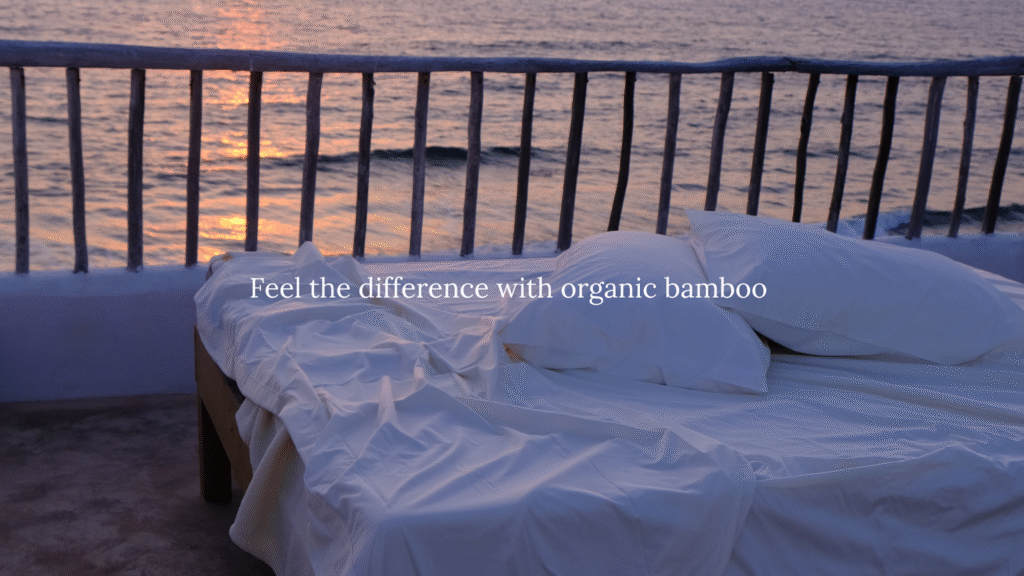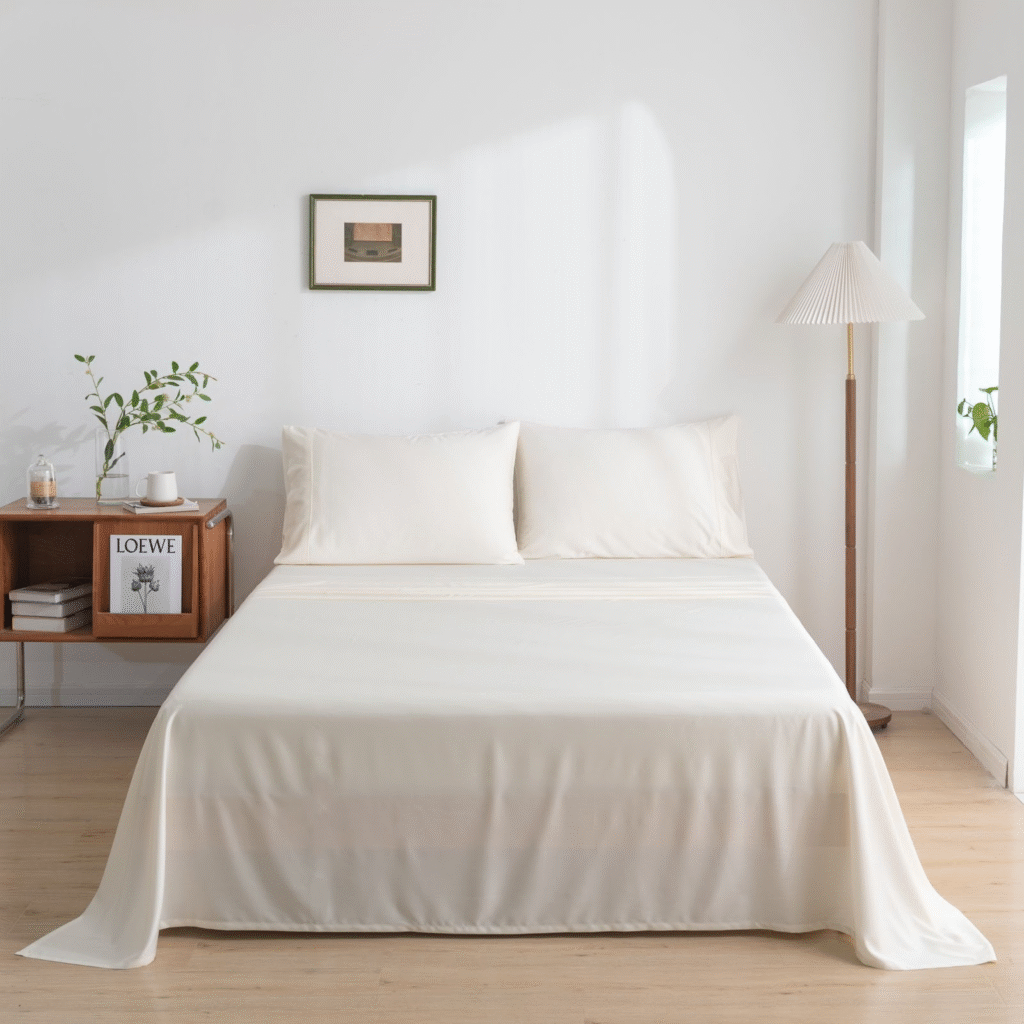Antibacterial Bedding Explained: Health Benefits, Drawbacks, And Is It Worth Buying?

Most people don’t give much thought to what they’re sleeping on beyond softness and style. Sheets? Check. A cozy duvet? Check.
But here’s the thing, your bedding isn’t just a backdrop for a good night’s sleep. It’s also the surface your skin presses against for six to eight hours every single day.
That means the fabrics you choose can directly impact your skin health, allergies, and even how refreshed you feel upon waking.
Enter antibacterial bedding, a newer category that’s been popping up in bedrooms everywhere. From bamboo fibers with natural antimicrobial properties to silver-infused pillowcases that claim to fight acne, the options are growing fast.
Marketers tout them as the secret to clearer skin, cleaner sleep, and a fresher-smelling bed. But does science back this claim, or is it all just clever advertising?
This guide breaks it all down. By the end, you’ll know whether upgrading your sheets, duvet covers, or pillowcases is a smart move for your sleep routine, or just another fad.
What Is Antibacterial Bedding?
At its core, antibacterial bedding is exactly what it sounds like, sheets, pillowcases, duvet covers, or mattress protectors designed to resist or slow the growth of bacteria.
While regular fabrics like cotton or polyester can quickly pick up sweat, oils, and microbes, antibacterial textiles are engineered (or naturally structured) to create a cleaner surface for sleep.
There are a few different categories worth noting:
- Natural antibacterial fabrics – Bamboo bedding is the most popular in this group. The bamboo plant produces fibers that are naturally resistant to microbial growth, making bamboo linen a favorite for people with sensitive skin or those who sweat at night.
- Infused fabrics – Some bedding incorporates silver or copper ions, which have long been studied for their antimicrobial properties. These ions disrupt bacterial cell growth, keeping sheets fresher for longer.
- Treated cotton or blends – Certain cotton sheets are finished with antibacterial coatings. These usually involve chemical processes, which raises questions about long-term safety and environmental impact.
It’s important to clear up a common misconception: antibacterial doesn’t always mean antiviral.
These sheets won’t necessarily protect you from viruses, but they can help reduce the bacterial load on surfaces that touch your skin for hours every night.
Compared to traditional bedding made from untreated cotton plant fibers or polyester, antibacterial bedding promises a fresher, more hygienic sleep experience.
Whether that promise is worth the higher thread counts and higher price tags is something we’ll explore in the coming sections.
How Does Antibacterial Bedding Work?
The idea behind antibacterial bedding is pretty simple: stop bacteria from multiplying where you sleep. But the way it actually works depends on the material.
Silver and copper-infused fabrics use ions to disrupt bacterial growth. When sweat or moisture comes into contact with the fabric, these ions interact with bacterial cells, essentially breaking down their ability to reproduce.
That’s why silver-infused pillowcases are often marketed to people with acne-prone or sensitive skin, they reduce the buildup of acne-causing microbes.
Bamboo fibers, on the other hand, take a more natural route. The bamboo plant produces a bio-agent sometimes called “bamboo kun,” which makes it harder for bacteria to thrive.
This means bamboo bedding can stay fresher for longer without needing heavy finishes or treatments. For hot sleepers who deal with sweat and odors, that’s a quiet but very real advantage.
Treated cotton works differently. It starts as high-quality cotton, sometimes even pima cotton or Egyptian cotton sheets, but then undergoes an additional process. This usually involves chemical coatings designed to resist microbes.
While effective at first, these finishes often fade with repeated washing and raise questions about environmental impact.
After all, bedding that involves chemical treatments doesn’t always align with eco-friendly values.
So, does antibacterial bedding kill bacteria completely? Not exactly. In most cases, it either slows bacterial growth or reduces how quickly microbes multiply.
The real benefit comes from fewer odors, less skin irritation, and a more hygienic sleep surface. Pair that with proper care like washing regularly, and you’ve got bedding that works with your skincare routine, not against it.
Key Health Benefits Of Antibacterial Bedding
So why are more people making the switch? The answer lies in the health benefits antibacterial bedding can bring, especially when it’s made from natural fibers like bamboo.
1. Fresher, Cleaner Sleep Surface
Traditional cotton plant fabrics absorb sweat and oils quickly, creating the perfect environment for bacteria.
Antibacterial options, like bamboo bedding or silver-infused sheets, help minimize this buildup, meaning your bed stays fresher between washes. That freshness often translates into a noticeably better night’s sleep.
2. Reduced Breakouts And Skin Irritation
For anyone struggling with acne or sensitive skin, your pillowcase may be part of the problem. Antibacterial fabrics slow the growth of acne-causing bacteria, reducing the chance of clogged pores.
Bamboo fibers, in particular, are smooth and less abrasive than higher thread counts of cotton, which can tug on skin.
If you’re serious about skincare, switching your pillowcase is one of the simplest upgrades. Our Sateen Pillowcases are designed to be gentle on sensitive skin while offering natural antibacterial benefits.
Ready to transform your night’s sleep? Apply PILLOWTALK20 for an exclusive 20% discount on your order.
3. Odor Control
Nobody wants bedding that smells stale after just a couple of nights. Antibacterial properties fight odor-causing microbes, which is especially helpful for hot sleepers who sweat more. Bamboo linen and silver-infused sheets are great options here.
4. Allergy-Friendly Sleeping
Dust mites, bacteria, and mold spores can trigger allergies and respiratory issues. Antibacterial bedding creates a less hospitable environment for these irritants, making it easier to breathe at night. Pair it with good washing habits and you’ve got a healthier sleep environment overall.
5. Longer Lifespan Of Fabrics
Bacteria don’t just affect your health, they also break down fabrics over time. By slowing bacterial growth, antibacterial bedding can actually extend the life of your investment, keeping high quality sheets feeling newer for longer.
Comparing Antibacterial Options
Antibacterial bedding isn’t a one-size-fits-all category. The materials and methods vary, and each comes with its own perks and compromises. Here’s a closer look:
Silver-Infused Bedding
Silver ions are known for their antimicrobial properties, and when woven into fabrics, they can disrupt bacterial growth.
The upside? Sheets and pillowcases stay fresher longer, which is a plus for acne-prone or sensitive skin.
The drawback is cost, silver-treated fabrics are pricey, and there’s ongoing debate about the long-term environmental impact of silver particles entering waterways through laundry.
Bamboo Bedding

Bamboo fibers stand out as a natural option. The bamboo plant produces a bio-agent that discourages microbial growth, making bamboo bedding naturally antibacterial.
Add to that its breathability, softness, and strong environmental profile, and you’ve got one of the best solutions for hot sleepers or anyone with sensitive skin. Unlike treated cotton, bamboo doesn’t rely on chemical finishes.
The only catch is that not all “bamboo” products are created equal, look for certifications to ensure quality.
A 2023 study evaluated untreated bamboo against zinc-oxide–treated cotton for microbial resistance and comfort. Bamboo outperformed, demonstrating strong antibacterial properties and notable comfort advantages, highlighting its suitability for skin-contact applications. (Dakuri & Lolla, 2023)
Treated Cotton
Cotton can be given antibacterial qualities through chemical treatments. While this works initially, the antibacterial coating often fades with washes.
Plus, it doesn’t align with eco-conscious values since it involves chemical finishes. That said, high quality pima cotton or Egyptian cotton sheets, while not naturally antibacterial are still durable and luxurious. For some, comfort outweighs the antibacterial factor.
Dermatologist Dr. Mona Gohara points out that bamboo and cotton fabrics are excellent choices for acne-prone skin because they’re breathable and wick away moisture. She adds that these materials minimize friction and irritation on areas that often break out, like the face and shoulders (Nesvig, 2025)
Other Materials
Copper-infused fabrics and microfiber blends also claim antibacterial properties, though they’re less common. Microfiber is affordable but not always breathable, which can be uncomfortable for hot sleepers.
For a sustainable choice that balances antibacterial properties, softness, and longevity, our Bamboo Sheets Collection offers a high-quality upgrade designed for healthier skin and a fresher night’s sleep.
Sleep better and glow brighter, use code PILLOWTALK20 at checkout for 20% off your bedding upgrade.
Who Should Consider Antibacterial Bedding?
Antibacterial bedding isn’t necessary for everyone, but for certain groups, it can make a meaningful difference in daily comfort and long-term skin health.
People With Sensitive Skin Or Acne-Prone Skin
If you struggle with breakouts or irritation, your pillowcase and sheets can play a bigger role than you think.
Fabrics that resist bacteria and wick away moisture create a cleaner sleep surface, reducing pore-clogging buildup.
Dermatologists often recommend breathable, antibacterial options like bamboo bedding to help minimize friction and irritation.
A 2024 study examining knitted fabrics made from bamboo, cotton, and viscose found that bamboo stands out for its antibacterial, hypoallergenic, and moisture-regulating characteristics, ideal for sensitive or breakout-prone skin. Akarslan Kodaloğlu, F. (2024)
Hot Sleepers And Night Sweaters
When you sweat at night, your sheets become a breeding ground for bacteria and odors. Antibacterial materials like bamboo fibers or silver-infused fabrics regulate temperature better and stay fresher between washes.
This not only makes your bed more comfortable but also ensures a healthier night’s sleep.
Allergy Sufferers
Dust mites and allergens thrive in warm, moist environments. Antibacterial bedding helps reduce microbial growth, which can ease allergy symptoms. Choosing bamboo sheets, in particular, offers a hypoallergenic solution that’s gentle on the skin while limiting irritants.
Families With Kids
Parents often face frequent spills, sweat, or messes. Bedding with antibacterial properties can help keep kids’ rooms cleaner and fresher with less effort. It’s not a replacement for regular washing, but it does provide an extra layer of protection.
Eco-Conscious Sleepers
Not everyone wants fabrics that involve chemical finishes. Naturally antibacterial materials like bamboo offer the benefits without compromising sustainability, making them great options for eco-minded shoppers.
Looking for a practical yet skin-friendly choice? Our Sateen Pillowcase Set combines antibacterial benefits with a smooth, gentle finish perfect for sensitive skin.
Treat yourself (and your skin), enjoy 20% off with promo code PILLOWTALK20 today.
Drawbacks & Misconceptions About Antibacterial Bedding

While antibacterial bedding offers compelling benefits, it’s important to address potential downsides and clear up common myths so readers can make an informed decision.
Not A Substitute For Washing
A common misconception is that antibacterial sheets never need to be washed. In reality, while they may resist odor and bacterial growth longer than standard fabrics, regular washing is still essential.
Sweat, dead skin cells, and natural oils build up regardless, which can affect hygiene and skin health.
Involves Chemical Treatments In Some Fabrics
Not all antibacterial bedding is created equal. Some options, such as certain cotton or polyester sheets, achieve their antimicrobial properties through chemical finishes.
While many are tested for safety, they may wear off over time and raise concerns for people with sensitive skin.
For this reason, natural alternatives like bamboo fibers, which are inherently resistant to microbes, are often considered safer and longer-lasting.
Cost Considerations
High-quality antibacterial bedding, especially bamboo or silver-infused fabrics, can come with a higher upfront cost compared to conventional cotton sheets.
However, the durability, freshness, and skin benefits often balance out the investment in the long run.
Not Always Eco-Friendly
Some antibacterial fabrics require resource-heavy processing, which can have a negative environmental impact.
Eco-conscious buyers need to research whether the product involves chemical finishes or if it’s naturally antibacterial, as with bamboo bedding.
Certifications like OEKO-TEX or GOTS (for cotton) can provide peace of mind.
For those without sensitive skin, allergies, or sweat issues, the difference may be subtle. While antibacterial bedding promotes hygiene, it’s not a “must-have” for everyone.
Is Antibacterial Bedding Worth Buying?
So, is antibacterial bedding really worth the investment? The answer depends on your lifestyle, skin type, and sleep habits.
For hot sleepers who sweat through the night, antibacterial fabrics like bamboo bedding or silver-infused sheets can feel like a game-changer.
They stay fresher for longer, resist odors, and help regulate temperature for a more comfortable night’s sleep. Those with sensitive skin or prone to breakouts may also notice fewer flare-ups thanks to reduced bacteria and less fabric friction.
If you’re already using high-quality bedding (think pima cotton or Egyptian cotton sheets with higher thread counts) and maintain a consistent laundry routine, the benefits may be less dramatic.
In those cases, antibacterial bedding feels more like an upgrade in convenience and comfort than a necessity.
If you want bedding that doubles as part of your skincare routine, antibacterial options, especially bamboo comforters, duvet covers, or pillowcases, are worth considering.
They won’t replace good hygiene or skincare practices, but they can support a cleaner sleep environment.
Conclusion
Bedding is more than just fabric, it’s the surface your skin touches for a third of your life. Antibacterial bedding can make that surface fresher, cleaner, and more supportive of a good night’s rest.
From reducing odor and bacteria growth to offering benefits for hot sleepers and sensitive skin, the right sheets or comforters can play a quiet but powerful role in your wellness routine.
Still, it’s not one-size-fits-all. If you want a naturally antibacterial, eco-conscious choice, bamboo fibers are an excellent option.
If you’re mainly after durability and tradition, cotton remains a great contender. At the end of the day, investing in antibacterial bedding is less about chasing trends and more about choosing comfort, health, and peace of mind.
Testimonials From Satisfied Customers Who Trusted Derme Home

You May Also Like Reading:
References
